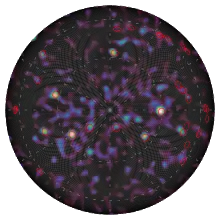Transient Array Radio Telescope
The Transient Array Radio Telescope (TART) is a low-cost open-source array radio telescope consisting of 24 all-sky GNSS receivers operating at the L1-band (1.575 GHz). TART was designed as an all-sky survey instrument for detecting radio bursts, as well as providing a test-bed for the development of new synthesis imaging and calibration algorithms. All of the telescope hardware including radio receivers, correlators and operating software are open source. A TART-2 radio-telescope can be built for approximately 1000 Euros, and the telescope antenna array requires 4m x 4m area for deployment.


Design
All of the components of TART, from the hardware, FPGA firmware and the operation and imaging software are open source.[1] released under the GPLv3 license. A TART radio telescope consists of four main sub-assemblies, the antenna array, RF Front End, radio Hub and basestation.
Antenna array
The antenna array consists of 24 antennas arranged on four identical 'tiles' with 6 antennas each. Each tile is a 1x1 meter square. The antennas used are low-cost, widely available commercial GPS active antennas.
RF front end

The Radio Frequency (RF) front ends receive the radio signals from each antenna. The RF front ends take advantage of low-cost, widely available, and very sensitive integrated circuits developed for global positioning satellite receivers. The TART uses the MAX2769C Universal GNSS Receiver[2] made by Maxim Integrated. This single integrated circuit includes all the elements required of a radio-telescope receiver; low-noise amplifier, local oscillator, mixer, filters and an ADC. Each RF front end generates a data-stream of digitized radio signals with 2.5 MHz bandwidth from the GPS L1 band (1.57542 GHz).

Radio Hub
The TART contains four radio hubs. Each has six RF front end receivers and clock distribution circuitry. Each radio hub sends data to the basestation, and receives the master clock signal from the basestation, over two standard CAT-6 twisted-pair ethernet cables.
Basestation

The basestation is a single PCB with an attached Raspberry Pi computer, and Papilio Pro FPGA daughter board. The basestation provides the 16.3767 MHz Crystal Oscillator which is distributed to the four radio hubs to provide synchronous clocking to the RF front ends. The data is returned from the radios via each radio hub to the basestation, consisting of 24 parallel streams of 1-bit samples. An FPGA processes these samples, acting as a radio correlator. The 276 correlations are sent to the Raspberry Pi host via SPI, and made available over a RESTful API.

Software
The TART telescope operating software is open-source and written in Python. It consists of several modules:
- A hardware driver that reads data from the telescope, via an SPI bus from the FPGA on the basestation.
- A RESTful API server that makes this data available via HTTP. This runs on the Raspberry Pi computer attached to the basestation.
- Software that performs aperture synthesis imaging based on the measurements.
Aperture synthesis imaging
The TART telescope can perform aperture-synthesis imaging of the whole sky in real-time. To do this the data from each of the 24 antennas is correlated with the data from every other antenna forming a complex interferometric visibility. There are 276 unique pairs of antennas, and therefore 276 unique complex visibility measurements. From these measurements, an image of the radio emission from the sky can be formed. This process is called aperture synthesis imaging.
In the TART, the imaging is normally done using a browser-based imaging pipeline. Three different pipelines have been written to date:
Development
TART was developed by a team from the department of Physics at the University of Otago starting in 2013 with TART-1, and in July 2019, TART-3 is under development.
TART-1
Development started in 2013 with TART-1, an M.Sc project developing 6-element proof of concept radio-interferometer. [3]
TART-2/2.1
TART-1 was followed by TART-2 which was the focus of a Ph.D research project. TART-2 consists of 24 elements and is capable of continuous all-sky imaging, with the 'first light' image being taken in August 2015. TART-2 was upgraded into TART-2.1 with reduce costs and improved clock stability. TART-2.1 started operation in 2018. [4]
TART-2 includes real-time correlation of the radio data from every pair of antennas. This correlation is carried out in the FPGA. There are 276 pairs of antennas, leading to 276 complex visibilities being calculated which are used as inputs to the synthesis imaging process. These visibilities are made available via the RESTful API[5] for live imaging, or downloading for further analysis.
TART-3
TART-3 started development in 2019. A TART-3 telescope will consist of 1-4 radio hubs each with 24 receivers. The maximum number of receivers in a single telescope increases to 96. TART-3 is designed to reduce construction costs, and simplify installation.TART-3 source code
TART Installations

There are currently two operational TART telescopes:
- Signal Hill, Dunedin, New Zealand.45.85177°S 170.5456°E TART-2.1. Operated by the University of Otago
- Stellenbosch, Stellenbosch, South Africa TART-2.1. Operated by Stellenbosch University
| Name | Location | Live URL | Version | Remarks |
|---|---|---|---|---|
| TART-2-signal | Signal Hill, Dunedin, New Zealand.45.85177°S 170.5456°E | Telescope Console | TART 2.1 | The first TART deployment. Operated by the University of Otago. |
| TART-2-za | Stellenbosch, Stellenbosch, South Africa 33.9284639°S 18.8663558°E | N/A | TART 2.1 | Operated by Stellenbosch University |
References
- "TART source code".
- "MAX2769C data sheet" (PDF).
- Shaw, Charles (2014). A Radio Interferometer Operating in the GPS L1 Band (MSc). University of Otago. hdl:10523/5121.
- Scheel, Max. (2019). Instrumentation and Calibration of the Transient Array Radio Telescope (PhD). University of Otago. hdl:10523/9538.
- "TART 2 API Documentation". TART 2 API Documentation. Retrieved 13 November 2019.
External links
- TART project website
- TART Github Repository
- TART VUER Source code Gitlab Repository for the improved telescope web interface
- Live images Mirror using the TART VUER interface.
